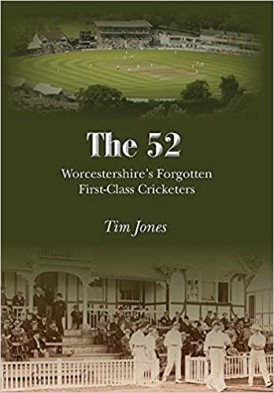The 52: Worcestershire’s Forgotten First Class Cricketers
Martin Chandler |Published: 2021
Pages: 283
Author: Jones, Tim
Publisher: Grosvenor House Publishing
Rating: 4 stars

Some books have a fairly limited appeal and, years ago, for that reason alone would never have seen the light of day. Publishers are, after all, in business to turn some sort of profit even if the margins they work on are rather slimmer now than in days gone by. This new book from Worcestershire historian Tim Jones is one such, and is not going to make a dent in the bestsellers lists. It is nonetheless a mightily impressive piece of research and, for the cricket tragics amongst us, an interesting read.
So the increasing ease with which researchers can now publish their own work is a boon to us all, and in this case I have to say I am impressed with the service that Grosvenor House Publishing have provided. The content of books like this one are, of course, the most important aspect of them, but it is certainly a bonus to be able to handle a nicely designed hard back with, as far as I can see, no grammatical or other errors and plenty of relevant and well reproduced illustrations even if some of them are a touch on the small side.
But you probably want to know what the book consists of? It is one of those ‘Who’s who’ books that have recently started to emerge from around the counties, albeit one with a somewhat unusual angle. As the sub title makes clear the subject of this one is the county of the three black pears. Worcestershire, I learnt only when I was told the book was being published, stopped awarding county caps back in 2005. At that point they decided, in the manner of the Test playing countries, to go back to when they were awarded First Class status in 1899 and allocate a number to all who had represented the county in the County Championship.
The concern that Tim Jones had with that approach was that it would ignore 52 men who, over the years, had represented the county in First Class fixtures, but never in the Championship. For many this would just be a single game against one of the Universities or the Combined Services, although Cecil Tipper played as many as five matches, all in 1919 when the county arranged a few matches, but not enough to be able to enter the Championship.
Each of the 52 receives a chapter of his own. These entries begin with basic biographical details followed by a potted score for the game(s) in which they played and a brief description of the match. That is followed by the results of Jones’s research into the lives of the 52. In the case of 16 of the 17 who are still with us that is based on interviews with the men themselves and, for a number of the others, conversations with descendants.
Who are these men? Almost by definition their names are from famous, although one England Test player does feature. Jones, quite correctly in my view, declines to treat Nick Compton as one of The 52, although his guest appearance for the county, at the request of the England selectors, against the Australians in 2013 does merit an account in the book’s introduction.
As to The 52 themselves there were only two names that I recognised, Brian Barrett and Guy Pawson. Barrett I recall as a member of the 1986 New Zealand touring party, although he never did get a Test cap. Pawson’s name I know because of the rather greater sporting achievements and two volumes of autobiography of his son, Tony, a more than useful amateur batsman for Kent and Oxford University just after the Second World War.
And the others? They are, of course, an eclectic selection and their careers went no further for a variety of reasons, albeit for the majority they just weren’t quite good enough. One who was an excellent sportsman was Harry Moule, who scored 45 and 57 in his only appearance. A draughtsman who was 31 when opportunity knocked in 1952 Moule reasoned that with two young children he had to keep his day job rather than gamble on a future as a professional sportsman.
Another who particularly caught my eye was Freddy Grisewood. One appearance for the county in 1908 was not particularly successful, but Grisewood went on to enjoy a long and successful career as a broadcaster. There is tragedy too, none more so than the life of perhaps the most accomplished cricketer among The 52, South African batsman Louis Vorster, whose sole appearance came against the 1988 West Indians. Vorster met a tragic end, killed in an armed robbery in 2012 at the age of 45.
There is sufficient detail in all of these pen portraits to make each of them a worthwhile read and if the admittedly niche subject matter appeals The 52 is certainly recommended. The standard edition is available on Amazon and there is also a limited edition signed by Jones and John Chadd, a member of The 52 who contributes an excellent foreword. The limitation is, naturally, 52 numbered copies and if anyone is interested in that one let us know and we will put you in touch with the author.






Leave a comment